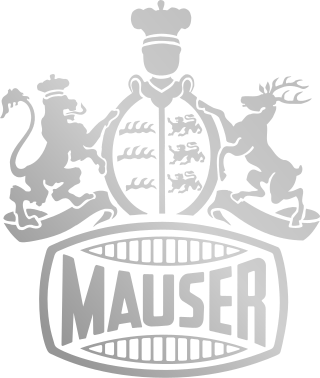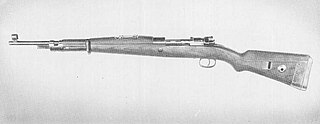
The Mosin–Nagant is a five-shot, bolt-action, internal magazine–fed military rifle. Known officially as the 3-line rifle M1891 and informally in Russia and the former Soviet Union as Mosin's rifle, it is primarily found chambered for its original 7.62×54mmR cartridge.

The Karabiner 98 kurz, often abbreviated Karabiner 98k, Kar98k or K98k and also sometimes incorrectly referred to as a K98, is a bolt-action rifle chambered for the 7.92×57mm Mauser cartridge. It was adopted on 21 June 1935 as the standard service rifle by the German Wehrmacht. It was one of the final developments in the long line of Mauser military rifles.

Mauser, originally Königlich Württembergische Gewehrfabrik , was a German arms manufacturer. Their line of bolt-action rifles and semi-automatic pistols has been produced since the 1870s for the German armed forces. In the late 19th and early 20th centuries, Mauser designs were also exported and licensed to many countries which adopted them as military and civilian sporting firearms. The Gewehr 98 in particular was widely adopted and copied, and is the foundation of many of today's sporting bolt-action rifles.

The vz. 52 rifle is a self-loading rifle developed shortly after the Second World War in Czechoslovakia. Its full name is 7,62mm samonabíjecí puška vzor 52. Vz. 52 is an abbreviation for vzor 52, meaning "model 52". It fires the unique 7.62×45mm cartridge. It is considered both reliable and accurate. The first 5000 vz. 52 rifles were made by Považské strojárne in Považská Bystrica, but due to production difficulties, its manufacture was taken over by Česká zbrojovka Uherský Brod.

The Gewehr 98 is a German bolt-action rifle made by Mauser, firing cartridges from a five-round internal clip-loaded magazine. It was the German service rifle from 1898 to 1935, when it was replaced by the Karabiner 98k, a shorter weapon using the same basic design. The Gewehr 98 action, using a stripper clip loaded with the 7.92×57mm Mauser cartridge, successfully combined and improved several bolt-action engineering concepts which were soon adopted by many other countries, including the United Kingdom, United States, and Japan. The Gewehr 98 replaced the earlier Gewehr 1888 as the main German service rifle. It first saw combat in the Chinese Boxer Rebellion and was the main German infantry service rifle of World War I. The Gewehr 98 saw further military use by the Ottoman Empire and Nationalist Spain.
The vz. 24 rifle is a bolt-action carbine designed and produced in Czechoslovakia from 1924 to 1942. It was developed from the German Mauser Gewehr 98 line, and features a very similar bolt design. The rifle was designed in Czechoslovakia shortly after World War I, to replace the Vz. 98/22, also a Czech-designed derivative of the Gewehr 98. The vz. 24 featured a 590 mm (23.2 in) barrel which was shorter and considered more handy than the 740 mm (29.1 in) Gewehr 98 barrel. The vz. 24 was chambered in 7.92×57mm Mauser like its predecessors.

The 7.92×57mm Mauser is a rimless bottlenecked rifle cartridge. The 7.92×57mm Mauser cartridge was adopted by the German Empire in 1903–1905, and was the German service cartridge in both World Wars. In its day, the 7.92×57mm Mauser cartridge was one of the world's most popular military cartridges. In the 21st century it is still a popular sport and hunting cartridge that is factory-produced in Europe and the United States.

The ZB vz. 26 was a Czechoslovak light machine gun developed in the 1920s, which went on to enter service with several countries. It saw its major use during World War II, and spawned the related ZB vz. 27, vz. 30, and vz. 33. The ZB vz. 26 influenced many other light machine gun designs including the British Bren light machine gun and the Japanese Type 97 heavy tank machine gun. The ZB-26 is famous for its reliability, simple components, quick-change barrel and ease of manufacturing. This light machine gun in the Czechoslovak army was marked as the LK vz. 26. ZB vz. 26 is incorrect nomenclature because "ZB-26" is a factory designation, while "vzor 26" or "vz. 26" is an army designation.

The Gewehr 88 was a late 19th-century German bolt-action rifle, adopted in 1888.

Zbrojovka Brno, s.r.o is a maker of small arms in Brno, Czechoslovakia, wholly owned by Colt-CZ Group. In the past it also made light artillery, cars, motorcycles, tractors and various tools, such as typewriters and early computers.
The Zastava M48 is a post World War II Yugoslav version of the German Karabiner 98k designed by Mauser and the Belgian designed M24 series. It was the standard service rifle of the Yugoslav People's Army from the early 1950s until its replacement by the Zastava M59/66, a licensed copy of the Soviet SKS semiautomatic carbine, in the early 1960s.

The ZB-30 and ZB-30J were Czechoslovakian light machine guns that saw extensive use during World War II.

The puška vz. 33 was a Czechoslovak bolt-action carbine that was based on a Mauser-type action, designed and produced in Československá zbrojovka in Brno during the 1930s in order to replace the obsolete Mannlicher vz. 1895 carbines of the Czechoslovak četnictvo (gendarmerie). The manufacturer's designation was vz. 16/33. Another version, the Vz. 12/33, was also produced for the Latin American market.

The 7.65×53mm Mauser is a first-generation smokeless powder rimless bottlenecked rifle cartridge developed for use in the Mauser Model 1889 rifle by Paul Mauser of the Mauser company. It is also known as 7.65×53mm Argentine, 7.65×53mm Argentine rimless, 7.65mm Argentine, 7.65×53mm Belgian Mauser or 7.65mm Belgian and 7.65×53mm Mauser.

Facing the threat of Western colonial expansionism in Southeast Asia during the later part of the 19th century, King Rama V of Siam, sought new weapons as part of a modernization program to ensure the kingdom's independence. After experiments with other rifles, the Siamese military decided to purchase a Mauser rifle based on the Gewehr 98 design as their principle service rifle. Through various modifications, adaptations, and using various cartridges, the Siamese Mausers served as the main infantry weapon of Siam until after World War II.

The FN Model 1924 series is a line of Mauser Gewehr 98 pattern bolt-action rifles produced by the Belgian Fabrique Nationale. They are similar to the Czech vz. 24 rifle, however have an intermediate length action, featuring open sights, 7.65×53mm, 7×57mm or 8×57mm IS chambering, Long rifle, Short Rifle and carbine-length barrels, hardwood stocks, and straight or curved bolt handles. This pattern rifle was discontinued from production and was no longer offered after 1932 being totally replaced by the 1930 pattern.

The Turkish Mauser can be used to describe many Mauser rifles used by the Ottoman Empire and then the Republic of Turkey.
The Standardmodell rifle is a bolt-action rifle designed to chamber the 7.92×57mm Mauser cartridge. The rifle was developed in 1924 but entered full-scale production in 1933. Officially designed for export and German security guards, it was used by the paramilitary Sturmabteilung (SA) and Schutzstaffel (SS). Export variants were used in South America, Ethiopia, China and the Iberian Peninsula. The carbine version of this rifle was almost identical with the Karabiner 98k that became the standard German service rifle during World War II.
The Steyr Model 1912 were Gewehr 98 pattern bolt-action battle rifles produced by Steyr before World War I. They were designed for export market. During the war, they were also used by the Austro-Hungarian Army.
The Mauser Model 1908 were series of Gewehr 98 pattern bolt-action rifles. First produced by Deutsche Waffen und Munitionsfabriken (DWM) and Mauser, they were exported to Uruguay and Brazil. In this latter country, Brazilian War Material Industry produced upgraded versions until the rifle was replaced by the FN FAL.
















